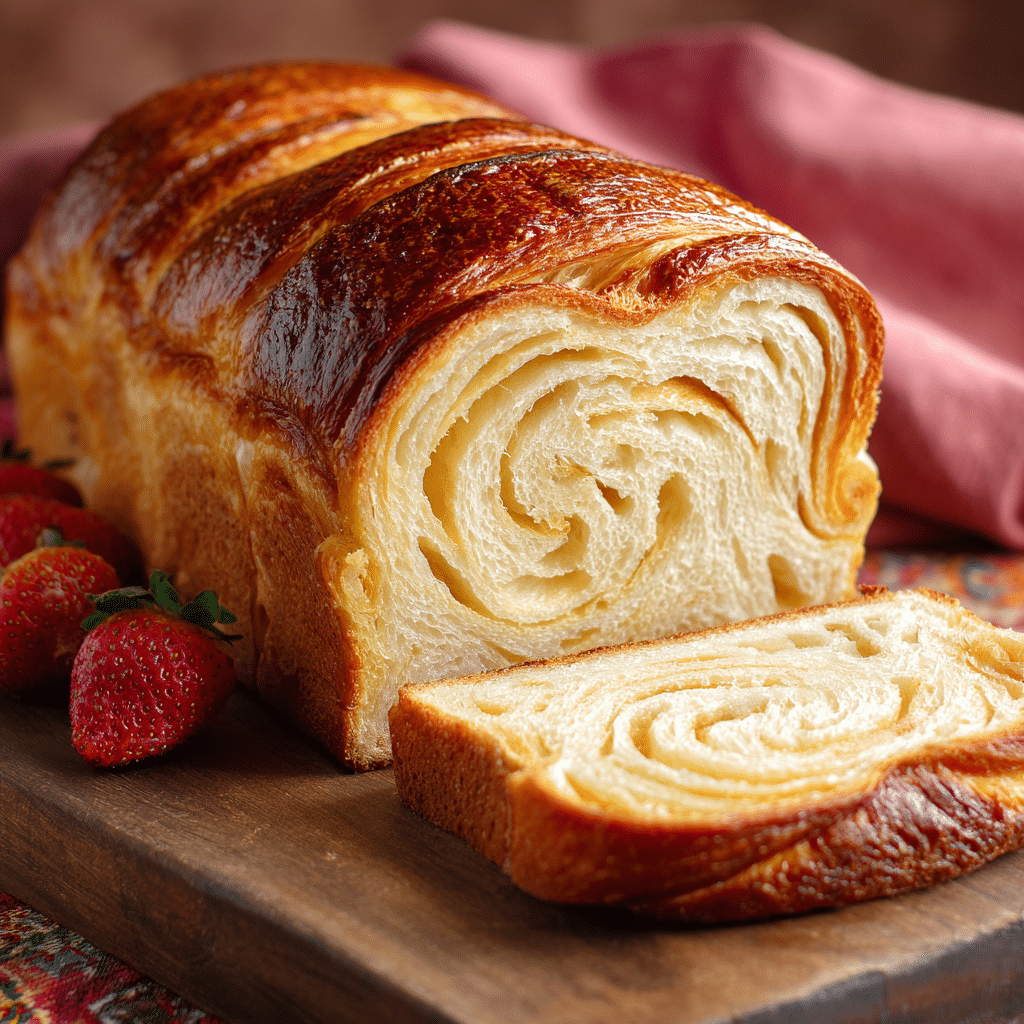Croissant Bread (Loaf) Recipe
If you dream of bakery-style breakfasts, let me introduce you to Croissant Bread (Loaf)—a recipe that combines the impossibly flaky, buttery layers of a classic croissant with the easy slice-and-serve convenience of a tender loaf. Whether you’re a longtime home baker or just starting your yeast adventures, this bread is pure magic: each bite shatters delicately, revealing spirals of rich dough and golden crust. Perfect for brunch, elegant sandwiches, or simply slathered with jam, Croissant Bread (Loaf) will quickly become a centerpiece in your kitchen traditions.
Ingredients You’ll Need

Ingredients You’ll Need
The secret to a show-stopping Croissant Bread (Loaf) is all about good, simple ingredients that work together to build irresistible flavor and an airy texture. Take a moment to gather everything and see how each element adds its own spark to this beautiful loaf.
- Whole milk: Adds richness and a lovely tender crumb; warming it helps activate the yeast.
- Instant or active dry yeast: Gives the bread its rise, turning that dough into a cloud-like masterpiece.
- Granulated sugar: Feeds the yeast for a healthy rise and brings just the right hint of sweetness.
- Salt: Essential for balancing flavor and boosting that buttery taste.
- Butter (both softened and for lamination): Divided for mixing into the dough and layering, butter is the heart of those iconic croissant layers.
- All-purpose flour: The backbone that gives our Croissant Bread (Loaf) its structure while keeping it light.
- Egg: Used in the egg wash, it creates that irresistible deep golden, shiny crust.
- Water: A splash in the egg wash helps it spread perfectly over the loaf.
How to Make Croissant Bread (Loaf)
Step 1: Mix the Dough
Start by whisking together your warm milk, yeast, and sugar in the bowl of your stand mixer (or in a mixing bowl by hand—no fancy tools required). Let it sit for about 5 minutes until it becomes foamy, a sign your yeast is awake and ready. This simple bloom sets the stage for those beautiful homemade layers.
Step 2: Build the Dough
Add the salt, softened butter, and most of the flour. Beat with your dough hook or mix using a wooden spoon until everything just comes together—don’t stress about a few butter bits. Then, add the rest of your flour and mix until you get a soft, slightly tacky dough that easily pulls away from the bowl. If it’s too sticky, sprinkle in a tablespoon or two of additional flour, but less is more for keeping things airy!
Step 3: Knead to Perfection
Kneading transforms your dough from shaggy to silky. If you’re using a mixer, let it run for 5 minutes, or turn the dough onto a lightly floured surface and knead by hand. When poked, the dough should bounce back gently, and a little “windowpane” test (stretching it to see light through without tearing) tells you you’ve nailed it. This step builds the strength that lets Croissant Bread (Loaf) rise to glorious, fluffy heights.
Step 4: Let the Dough Rise
Pop your dough ball into a greased bowl, turning it once so every inch is covered and won’t stick. Cover loosely and let it rise in a warm spot until nearly doubled—this can take about 1.5 to 2 hours. This first rise is when the real flavor starts developing and your kitchen might begin to smell like a French bakery.
Step 5: Shape and Chill
Gently punch down the dough to knock out excess air, then shape it into a rectangle on a silicone mat or parchment-lined sheet. Carefully stretch it to about 10-by-14 inches. Cover and chill for 20 minutes; this quick rest makes the next laminating step smooth and frustration-free.
Step 6: Prep the Butter for Lamination
Laminate like a baker! Slice your salted butter into thin slabs (about 1/4-inch thick). The consistency here matters; slightly soft but not melting is perfect. Chilled dough plus just-pliable butter ensures those beautiful, distinct croissant layers.
Step 7: First Lamination Fold
Arrange butter slices in a solid layer down the center third of the dough. Fold the edges over like a business letter, encasing the butter. Lightly roll the dough into a big rectangle again, fold it up the same way, wrap, and chill for 20 minutes. This process feels almost meditative—the first step toward those unmistakable flaky spirals.
Step 8: Second and Third Laminations
Repeat the rolling and folding two more times, rotating the dough each time and refrigerating between rounds. Each fold tucks in more layers, building the signature texture of Croissant Bread (Loaf). Patience here is your best friend—it’s absolutely worth the effort!
Step 9: Final Fold and Shape
Give your dough one last roll, and then roll it tightly (like a jelly roll) from the short edge. Cut this log into five even pieces—you don’t need to be super precise. Place them seam side down in a greased loaf pan. The rolled sections will help create those lush, pull-apart layers when you slice into the finished bread.
Step 10: Second Rise
Cover up and let the loaf rest one more time, about 45 to 60 minutes, until puffy but not doubled. This final rise gives your Croissant Bread (Loaf) the last push of air it needs for a high, tender crumb.
Step 11: Egg Wash and Bake
Preheat your oven and whisk together the egg with a tablespoon of water. Generously brush your loaf so it bakes up incredibly golden and shiny. Bake for about an hour, tenting with foil halfway if the top browns quickly. A thermometer reading of 195°F at the center means it’s perfectly done—expect the aroma to utterly fill your home!
Step 12: Cool and Enjoy
Let your Croissant Bread (Loaf) cool in the pan for 30 minutes, then transfer the loaf to a rack and cool at least 15 more (the hardest part is resisting a warm slice!). Fresh out of the oven, this bread is delicate; waiting before slicing prevents it from crumbling and preserves those dreamy layers.
How to Serve Croissant Bread (Loaf)

Garnishes
Trust me, a simple pat of good butter or swipe of fruit preserves is all you need to make your Croissant Bread (Loaf) unforgettable. For a brunch-worthy finish, dust it with a touch of powdered sugar or drizzle with honey. If you’re feeling decadent, a dollop of whipped cream or a handful of fresh berries makes every bite a celebration.
Side Dishes
Croissant Bread (Loaf) pairs perfectly with breakfast classics—think fluffy scrambled eggs, crisp bacon, or a fresh green salad for a lighter affair. For lunch, try it alongside hearty soups or delicate smoked salmon, letting the bread’s complex flavor hold its own at any table.
Creative Ways to Present
Slice it thick and toast until crisped for a truly special base for eggs Benedict or French toast. Mini sandwiches made with Croissant Bread (Loaf) are an instant hit at brunch buffets or afternoon tea. Or simply cube leftovers to make the most luxurious bread pudding you’ve ever tasted.
Make Ahead and Storage
Storing Leftovers
If you find yourself with extra Croissant Bread (Loaf), lucky you! Store well-wrapped slices at room temperature for up to three days; a sealed container preserves freshness and prevents the delicate crumb from drying out. For longer storage, the refrigerator can hold your loaf for up to a week—just let it come to room temp before enjoying for the best texture.
Freezing
Croissant Bread (Loaf) freezes beautifully. Let the loaf cool completely, then wrap tightly in plastic wrap and foil. Freeze whole or in thick slices for up to three months. When cravings hit, thaw at room temperature or overnight in the fridge for bakery-fresh flavor anytime.
Reheating
To revive that just-baked magic, reheat slices in a toaster or low oven (300°F) until lightly warmed—just a few minutes does the trick! If frozen, no need to defrost fully before toasting. For extra decadence, a gentle heat with a slather of fresh butter brings those flaky layers right back to life.
FAQs
Can I make Croissant Bread (Loaf) without a stand mixer?
Absolutely! While a mixer with a dough hook makes kneading easier, you can mix and knead the dough entirely by hand with a sturdy wooden spoon and a little elbow grease. Just allow extra time for mixing and be patient during kneading for that smooth, elastic texture.
Why is my dough tearing during lamination?
If your dough tears, it’s probably a touch too cold or has been over-stretched. Let it rest for five minutes to relax the gluten, patch up any spots with a sprinkle of flour, and then continue. Those tears won’t ruin the loaf—think of them as rustic character!
What’s the best way to tell if my Croissant Bread (Loaf) is fully baked?
The surest way is to use an instant-read thermometer; your bread is done at 195°F in the center. If you don’t have one, look for a deep golden top and a hollow-sounding thump when you tap the loaf—classic artisan bread signs.
Can I use unsalted butter for lamination?
Definitely! Both salted and unsalted butter work; with unsalted, just add an extra pinch of salt to the dough for that classic savory croissant flavor. What matters most is that the butter is cold but still pliable, ensuring perfect lamination.
Is it possible to prepare Croissant Bread (Loaf) dough ahead of time?
Yes! You can prepare the dough up through the initial rise, then refrigerate it overnight to slow the process. Bring it back to cool room temperature before proceeding with lamination for best results—an excellent trick for fitting homemade croissants into a busy schedule.
Final Thoughts
If you’re searching for a project that’s equal parts impressive and comforting, Croissant Bread (Loaf) will completely win you over. The process is surprisingly rewarding (and a bit magical) with results that taste straight from a Parisian bakery. Give it a try—you’ll be so glad you did!
PrintCroissant Bread (Loaf) Recipe
Learn how to make a delightful Croissant Bread Loaf that’s perfect for breakfast or as a snack. This homemade bread is buttery, flaky, and absolutely delicious.
- Prep Time: 30 minutes
- Cook Time: 1 hour
- Total Time: 3 hours
- Yield: 1 loaf 1x
- Category: Bread
- Method: Baking
- Cuisine: French
- Diet: Vegetarian
Ingredients
For the Dough:
- 1 cup (240ml) whole milk, warmed to about 110°F (43°C)
- 2 and 1/4 teaspoons (7g) instant or active dry yeast (1 standard packet, see Notes)
- 3 Tablespoons (38g) granulated sugar
- 1 and 1/4 teaspoons salt
- 3 Tablespoons (43g) unsalted or salted butter, softened to room temperature and cut into 3 equal pieces
- 3 cups (375g) all-purpose flour (spooned & leveled), plus more as needed and for lamination
- 3/4 cup (12 Tbsp; 170g) salted butter, slightly softened (see Notes)
- 1 large egg, cold or room temperature
- 1 Tablespoon (15ml) water
Instructions
- Prepare the Dough: Whisk warm milk, yeast, and sugar in a stand mixer. Add salt, butter, and 2 cups of flour. Beat until a soft dough forms.
- Knead the Dough: Beat or knead for 5 minutes until the dough is soft and slightly tacky.
- 1st Rise: Allow the dough to rise in a greased bowl for 1.5–2 hours.
- Flatten Dough: Flatten the dough into a rectangle and chill in the refrigerator for 20 minutes.
- Prepare for Lamination: Cut butter into slices and ensure it’s not too soft.
- 1st Lamination: Roll out the dough, fold in the butter, and refrigerate.
- 2nd & 3rd Laminations: Repeat rolling and folding, refrigerating between each lamination.
- Final Lamination & Shaping: Roll dough, fold, and shape into rolls.
- 2nd Rise: Place rolls in a loaf pan and allow to rise.
- Bake: Brush with egg wash and bake at 350°F for 1 hour.
- Cool & Serve: Cool in the pan, then on a wire rack before slicing and serving.
Notes
- Watch the tutorial video before starting.
- Make room in the refrigerator for the baking sheet.
- Ensure butter is not too soft for lamination.
- Do not extend refrigeration times during lamination.
Nutrition
- Serving Size: 1 slice
- Calories: 250
- Sugar: 5g
- Sodium: 200mg
- Fat: 14g
- Saturated Fat: 8g
- Unsaturated Fat: 5g
- Trans Fat: 0g
- Carbohydrates: 28g
- Fiber: 1g
- Protein: 4g
- Cholesterol: 45mg
Keywords: Croissant Bread, Bread Loaf, Homemade Bread Recipe








